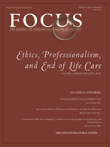Analysts Who Commit Sexual Boundary Violations: A Lost Cause?
Abstract
The causes of sexual misconduct by analysts are discussed, as is the viability of rehabilitation for different types of transgressors. Common misunderstandings about the transgressor (such as the assumption of psychopathy and the likelihood of multiple offenses) are countered with a summary of data derived from the evaluation and/or treatment of over two hundred cases, most of them one-time transgressors. The typical characteristics of the analyst or therapist who engages in sexual misconduct are presented and discussed as qualities that are to some extent present in analysts generally. The temptation to deny this universal vulnerability is viewed as effectively replicating the kind of vertical splitting or compartmentalization that makes one vulnerable to sexual misconduct in the first place.
(Reprinted with permission from J Am Psychoanal Assoc 2003; 51(2):617–636)



